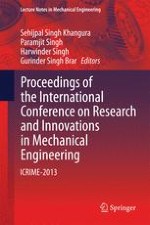This book comprises the proceedings of International Conference on Research and Innovations in Mechanical Engineering (ICRIME 2013) organized by Guru Nanak Dev Engineering College, Ludhiana with support from AICTE, TEQIP, DST and PTU, Jalandhar. This international conference served as a premier forum for communication of new advances and research results in the fields of mechanical engineering. The proceedings reflect the conference’s emphasis on strong methodological approaches and focus on applications within the domain of mechanical engineering. The contents of this volume aim to highlight new theoretical and experimental findings in the fields of mechanical engineering and closely related fields, including interdisciplinary fields such as robotics and mechatronics.
